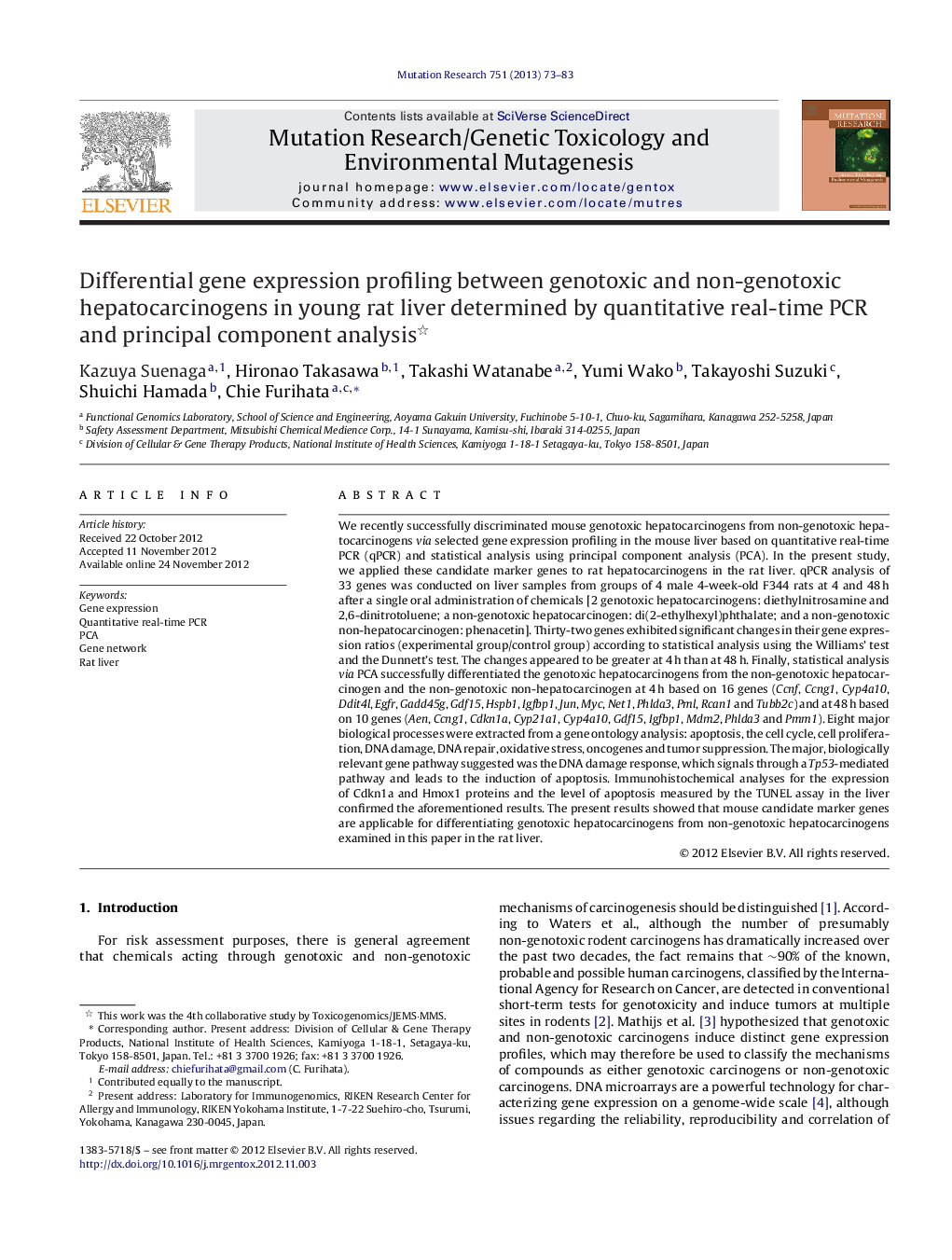| کد مقاله | کد نشریه | سال انتشار | مقاله انگلیسی | نسخه تمام متن |
|---|---|---|---|---|
| 2148066 | 1089529 | 2013 | 11 صفحه PDF | دانلود رایگان |

We recently successfully discriminated mouse genotoxic hepatocarcinogens from non-genotoxic hepatocarcinogens via selected gene expression profiling in the mouse liver based on quantitative real-time PCR (qPCR) and statistical analysis using principal component analysis (PCA). In the present study, we applied these candidate marker genes to rat hepatocarcinogens in the rat liver. qPCR analysis of 33 genes was conducted on liver samples from groups of 4 male 4-week-old F344 rats at 4 and 48 h after a single oral administration of chemicals [2 genotoxic hepatocarcinogens: diethylnitrosamine and 2,6-dinitrotoluene; a non-genotoxic hepatocarcinogen: di(2-ethylhexyl)phthalate; and a non-genotoxic non-hepatocarcinogen: phenacetin]. Thirty-two genes exhibited significant changes in their gene expression ratios (experimental group/control group) according to statistical analysis using the Williams’ test and the Dunnett's test. The changes appeared to be greater at 4 h than at 48 h. Finally, statistical analysis via PCA successfully differentiated the genotoxic hepatocarcinogens from the non-genotoxic hepatocarcinogen and the non-genotoxic non-hepatocarcinogen at 4 h based on 16 genes (Ccnf, Ccng1, Cyp4a10, Ddit4l, Egfr, Gadd45g, Gdf15, Hspb1, Igfbp1, Jun, Myc, Net1, Phlda3, Pml, Rcan1 and Tubb2c) and at 48 h based on 10 genes (Aen, Ccng1, Cdkn1a, Cyp21a1, Cyp4a10, Gdf15, Igfbp1, Mdm2, Phlda3 and Pmm1). Eight major biological processes were extracted from a gene ontology analysis: apoptosis, the cell cycle, cell proliferation, DNA damage, DNA repair, oxidative stress, oncogenes and tumor suppression. The major, biologically relevant gene pathway suggested was the DNA damage response, which signals through a Tp53-mediated pathway and leads to the induction of apoptosis. Immunohistochemical analyses for the expression of Cdkn1a and Hmox1 proteins and the level of apoptosis measured by the TUNEL assay in the liver confirmed the aforementioned results. The present results showed that mouse candidate marker genes are applicable for differentiating genotoxic hepatocarcinogens from non-genotoxic hepatocarcinogens examined in this paper in the rat liver.
► We studied gene expression profiling in genotoxic and nongenotoxic hepatocarcinogens.
► We applied 33 genes selected from our previous mouse hepatocarcinogen studies.
► We quantified gene expression profiling in rat liver by quantitative real-time PCR.
► We successfully used principal component analysis (PCA) for statistical analysis.
► We differentiated between genotoxic and non-genotoxic hepatocarcinogens by PCA.
Journal: Mutation Research/Genetic Toxicology and Environmental Mutagenesis - Volume 751, Issue 1, 18 February 2013, Pages 73–83